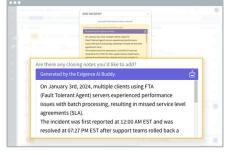- December 2024 (1)
- January 2024 (1)
- December 2023 (1)
- November 2023 (1)
- September 2023 (1)
- July 2023 (1)
- May 2023 (1)
- February 2023 (1)
- January 2023 (1)
- November 2022 (2)
- October 2022 (1)
- September 2022 (1)
- August 2022 (1)
- March 2022 (1)
- January 2022 (1)
- December 2021 (1)
- July 2021 (1)
- June 2021 (1)
- April 2021 (1)
- March 2021 (2)
- February 2021 (1)
- January 2021 (2)
- December 2020 (2)
- November 2020 (1)
- October 2020 (2)
- September 2020 (2)
- August 2020 (2)
- June 2020 (1)
- May 2020 (1)
- March 2020 (2)
- January 2020 (1)
- November 2019 (2)
- September 2019 (1)
- August 2019 (2)
- July 2019 (4)
- June 2019 (1)
- February 2019 (1)
- December 2018 (1)
- September 2018 (1)
- April 2018 (1)
- March 2015 (1)
Exigence is providing a command and control center software to manage major incidents.
As opposed to regular IT incidents, critical incidents often require a high level of collaboration involving team members from different parts of the organization and even outside of it, who are using different tools and processes. This collaboration is generally not structured resulting in painful and expensive delays.
With its command and control center Exigence automates the collaboration and structures it around a timeline that records the steps taken to resolve an incident and drives workflows across stakeholders and tools, thus ensuring all stakeholders are working off the same page. The product ties together stakeholders, processes and the tools already in use, driving down time to resolution. It uniquely addresses the full life cycle of the incident, turning an unstructured situation into one that is structured and easy to manage.
A New Approach
When it comes to critical incidents it's not enough to merely respond. And, point solutions for alerting, ticketing, and communications alone won't get the job done.
Indeed, the traditional approach to critical incidents is no longer relevant, organizations need a solution that involve all stakeholders and addresses every aspect of the incident workflow, from trigger to post-mortem. It should execute actions directly as well as integrate with all of the relevant incumbent systems, such as ticketing, chat, paging, monitoring, and more.
Solution
In the Exigence Command and Control Center, all stakeholders can align quickly on a single pane of glass. gaining unprecedented clarity on roles and responsibilities through automated task assignment and updates.
Through recording all relevant steps taken to address major incidents, Exigence introduces structure, clarity, and speed to critical incident management, enabling complete command and control of every incident from trigger to post-mortem.
Whether for technology operations or security incidents, or for drills and business continuity tests, It uniquely addresses every aspect of the incident, turning an unstructured situation into one that is structured and easy to manage.
The platform orchestrates complex workflows, automatically onboarding cross-functional, cross-organizational and external teams, and makes sure that everyone is always on the same page.
With easy reporting, on-the-fly documentation, and knowledge-management - the post-mortem is simplified, and the organization is always learning and optimizing.
Since Exigence can integrate with all of the relevant incumbent and future systems, coordinating, complementing, and augmenting their capabilities, the organization can keep using and benefiting from trusted ticketing, communications, CRM, project management, and other applications.
Moreover, for optimizing the management of future incidents, the Exigence platform also enables incident drills and tabletop simulations.
Benefits
- A faster time to resolution
- Eliminating time wasters, such as participating in lengthy conference calls and repeatedly providing updates
- More effective, structured collaboration - fully aligned stakeholders
- Increased accountability
- Reduced frustrations and friction issues
- Enhanced learning
- Increased trust among internal and external customers
- Reduced risk
- Enhanced compliance
Introducing structure to a complex and often unpredictable process.












